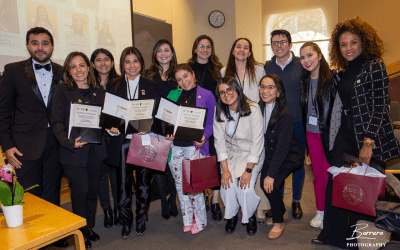
About the Author
Lara Norgaard is a Ph.D. candidate in Comparative Literature at Harvard University, where she researches Cold War cultural circulation between Latin America and Indonesia. She is also an essayist and literary translator, and her writing and translations have appeared in Public Books, The Jakarta Post, Asymptote Journal, The Transpacific Literary Project, and Cuíer: Brazil (Two Lines Press), among other publications. Her translation of the Indonesian novel 24 Hours with Gaspar (Seagull Books) was awarded a 2021 PEN/Heim Translation Grant, and she is currently pursuing her second novel-length translation from the Indonesian, People from Oetimu, forthcoming from Archipelago Books.
Upending the Archive
Notes from Researching Third World Ties in Brazilian Cinema Novo
“I made a movie in Africa because I knew that it was time to break down the self-isolation in which various Third World cinemas exist. The title—”The Lion Has Seven Heads”—came exactly from that idea: the same film and its many expressions, seven, seventy, seven hundred.” Brazilian director Glauber Rocha wrote these words in March 1970 as he was filming one of the strangest experimental movies of his career in Congo-Brazzaville. At the time, Glauber—as he is referred to in Brazil—was in exile from Brazil’s military dictatorship (1964-1985) for his leftist politics and the revolutionary, anti-imperialist tenor of his films, which by this point were considered a cornerstone of the Cinema Novo movement. It was after the Brazilian military coup that Glauber began developing a theory of Tricontinental cinema, a concept unifying an independent style of politically committed film production in Asia, Africa and Latin America that resists imitating either Hollywood or Soviet socialist realism.

Film poster for The Lion Has Seven Heads (1970)
Glauber’s The Lion Has Seven Heads, or Der Leone Have Sept Cabeças (1970) is arguably the film that most explicitly puts this theory into practice, at least in terms of its transnational premise. Here, a white preacher, a Latin American revolutionary, the CIA, local resistance movements and a puppet leader converge in a bizarre, hallucinogenic film reflecting on colonial desire and the possibilities and failures of anti-imperialist revolution. It is a film clearly born of Cold War international politics—of Che Guevara’s framework on revolution, of Patrice Lumumba’s assassination, of Almícar Cabral’s transnational independence struggles, and of Brazil’s own U.S.-supported military dictatorship, and by extension, Glauber’s exile.
But what was Glauber Rocha’s relationship to the Third World in both material connections and theoretical frameworks prior to The Lion Has Seven Heads—indeed, from the inception of Cinema Novo as a movement in the late 1950s? And to what extent did Cinema Novo directors actually interact with Asian and African filmmakers and cinematic traditions as they inscribed Brazilian film into the Third World?
These are the questions that led me to spend a São Paulo heat wave in the Brazilian Cinematheque, where I poured over early issues of film magazines like Cine Cubano and Filme Cultura and enlisted the help of several archivists to decipher Glauber’s nearly incomprehensible handwriting in his field notes from Dakar. Housed in a reclaimed red brick building that functioned as a slaughterhouse in the late 19th and early 20th centuries, Brazil’s Cinematheque is the largest film archive in Latin America. Not only does it maintain old and rare films, but the archive also hosts the personal papers of towering figures from Brazilian Cinema, including those of Glauber Rocha and Paulo Emilio Cesar Gomes, founder of the Cinematheque and one of Brazilian cinema’s most important critics and advocates.

Exterior of the Brazilian Cinematheque, São Paulo, Brazil. Photo by author.
When I entered the archive, I sought to understand Brazilian cinema’s broader framework for engaging the Third World, but I also investigated a more specific set of transnational ties from the 1950s and 1960s: those connecting Brazilian and Indonesian cinematic traditions. For my Harvard dissertation in Comparative Literature, I investigate how residues of Third World literary and film networks from the 1950s and 1960s inflect collective memory of Cold War dictatorships. The project specifically hinges on the staggered chain of coups in Brazil (1964), Indonesia (1965), Chile (1973), and Argentina (1976) and their aftermaths. The cultural relationships forged by Third World solidarity movements came to an end in these countries as right-wing regimes carried out programs of political persecution and censorship. I suggest, however, that collective memory of these dictatorships—and resistance to them—carry traces of cultural networks connecting these sites, networks grounded in leftist internationalism and Third World solidarity movements from the post-World War II period.
My initial idea for the project arose from firsthand observations of connections between Indonesia and Latin America. I worked in Jakarta in 2019, interviewing writers about their portrayals of the Suharto dictatorship in poetry and fiction, but I soon noticed unexpected connections to Latin America. I saw, for example, Indonesian mothers gather in front of the country’s capitol building every Thursday, demanding truth and justice for the dead and disappeared. Recognizing the evident similarities between this movement—known as “Aksi Kamisan,” or Thursday Action—and the Argentinian Mothers of the Plaza de Mayo, I spoke to one of the Indonesian mothers who founded the movement and learned that she and other organizers had taken inspiration from Argentina in their advocacy efforts. Intrigued by the unexpected connection, I wanted to see where the roots of these political ties began. Conversations with members of the 1990s student movement, former political prisoners, independent publishers and translators led me to see longstanding patterns of reception of Spanish- and Portuguese-language Latin American texts in Indonesia, beginning in the 1950s and continuing through to the present.
When I left Indonesia, I took with me a growing collection of books, documents and interviews as well as a fresh outlook on archival research. Archives are political; they make visible some historical figures while obscuring others, separate and divide information as much as they place documents in dialogue, and often emphasize the nation as the primary unit for collecting information. The corpus of Indonesian materials I gathered about Latin America is not easily searchable in any library catalogue. Instead, my research is a question of both social relations and the physical archive: I find materials because of references mentioned during my conversations with activists and writers, access to private archives containing texts that were censored for years and circulated clandestinely, and key terms that I thought to employ in library catalogues because of my conversations outside of the archive. To analyze texts in movement between Brazil, the Southern Cone of Latin America, and Indonesia, I must upend the archive, read through its crevices, and cross-reference distant collections of documents.

Stacks at the Brazilian Cinematheque, São Paulo, Brazil. Photo by author.
When I first corresponded with archivists at the Brazilian Cinematheque, I suspected that the key term “Indonesia” would yield few results (I was correct: the only hit this key term gave me was a retrospective of Indonesian Cinema held during the 1982 International Film Festival in Berlin). But this did not surprise or dishearten me. Based on conversations I had with the archivists and filmmakers from Glauber’s generation, such as the famous documentary filmmaker Silvio Tendler, I chose a more circuitous approach, searching for plausible points of interaction at left-leaning film festivals in the 1960s. I soon found, for example, references to Indonesian delegates present at the 1962 Karlovy Vary International Film Festival, an event that emphasized participation from new film industries in Asia, Africa and Latin America. The Czech festival was, moreover, a defining moment in Cinema Novo’s rise to international prominence, with movies such as Glauber’s Barravento (1962) taking home major awards. Or, as the first issue of Filme Cultura puts it: “Cinema Novo only became an international phenomenon in 1962.” Indonesian delegates witnessed this moment of reception and indeed participated in the symposia that framed the early success of Brazilian Cinema Novo. For now, details such as these are simply exciting leads. I need to return to different archives and crosscheck my findings with Indonesian newspaper and magazine clippings to see how Indonesian critics received Brazilian cinema at this crucial juncture.

Delegates from Asia, Africa, and Latin America meet at the Karlovy Vary International Film Festival in 1962. Photo from: “El XIII Festival Cinematográfico Internacional de Karlovy Vary,” Cine Cubano 7 (1962): 11.
Overall, this archival investigation attends to a few short years of history; I primarily look for Third World ties prior to Indonesia’s 1965 coup and prior to the intensification of censorship
and repression under the Brazilian dictatorship in 1968. However, the project strikes me as significant precisely because it was so short lived. Both Brazilian and Indonesian radical cinema movements committed to concepts of the Third World disappeared from national cultural production in the late 1960s. One of the documents I came across at the Cinematheque was a text authored by Paulo Emilio Salles Gomes in 1975, just over a decade after Cinema Novo’s first international success. And in his essay, the film critic comments on the near-total disappearance of Glauber Rocha’s work from Brazilian screens. In a context of dictatorship censorship, he writes: “It’s been a long time since Brazil has seen one of Glauber’s recent films. Everyone eagerly waits, but in the meantime, people get a sense of what he’s doing by reading scripts, foreign magazines, truncated telegrams published by Golias. . .” Paulo Emilio continues to explain that Glauber’s recent films, including The Lion Has Seven Heads, represent an “archaic” Third World—and laments that such movies might find little to no audience in the Brazil of the mid-1970s.
In other words, the Glauber Rocha with whom I began this article, the Glauber writing from Dakar in 1970 about his vision of the Third World in Brazzaville, engaged concepts of transnational solidarity and polemics of Third Cinema that had largely expired in Brazil domestically. And this, I find, is the challenge and significance of my research: not only do I investigate cultural movements and networks of people, but I do so because I recognize the disappearance of those modes of thought and trace their ghostly presence in cultural production after periods of political persecution. The work, in the case of Indonesian and Brazilian cinema, has only just begun.
More Student Views
Colombian Women Who Empower Dreams
English + Español
The verraquera of Colombian women knows no bounds. This was the message left with me by the March 30 symposium, “Empowering Dreams: 1st symposium in honor to Colombian women at Harvard.”
A Review of Born in Blood and Fire
The fourth edition of Born in Blood and Fire is a concise yet comprehensive account of the intriguing history of Latin America and will be followed this year by a fifth edition.
Resilience of the Human Spirit: Seizing Every Moment
In the heart of Chicago, where I grew up, amidst the towering shadows of adversity, the lingering shadows of generational demons and the aroma of temptation, the key to the gateway of resilience and determination was inherited. The streets of my childhood neighborhood became, for many, prisons of poverty, plundering, crime and poor opportunity.




